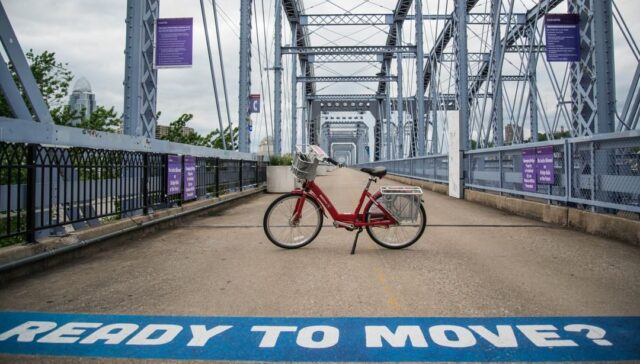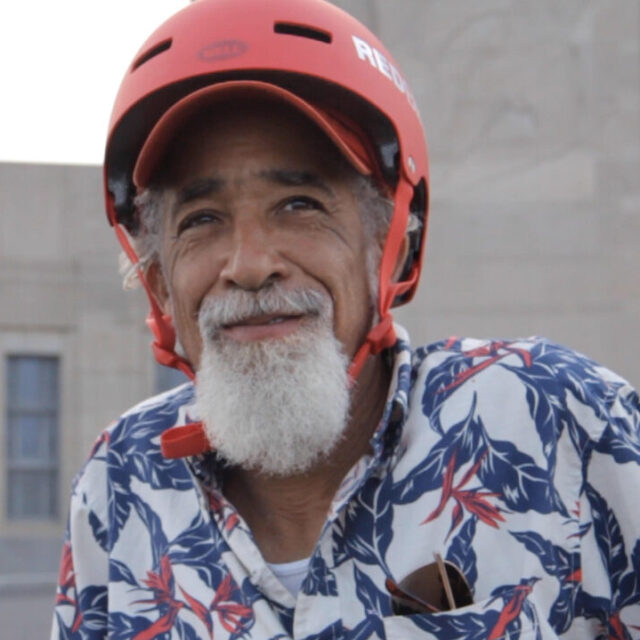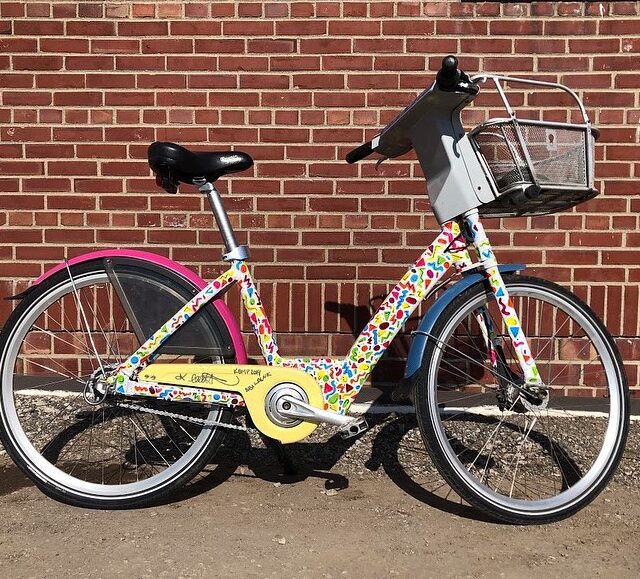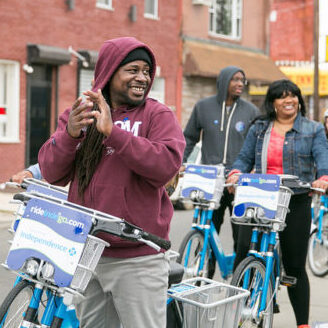Red Bike Bets Big on New Docks, Art and Cincinnati Youth
by Kiran Herbert, Communications Manager
March 4, 2021
This article is the first in a series profiling our five Living Labs, all of which will create replicable programs for improving bike share in low-income and historically marginalized communities.

Photo courtesy of Red Bike
Cincy Red Bike, the 58-station bike share system serving Cincinnati and Northern Kentucky, first launched in 2014. In 2019, Red Bike experienced a record year, thanks in large part to the introduction of 100 electric-assist bicycles into its fleet and the launch of the Red Bike Go program in the spring of 2018. The latter offers discounted memberships for folks with limited income—in 2019, the program accounted for 28% of Red Bike users, making it amongst the more successful bike share equity initiatives in the country.
Nevertheless, Red Bike’s Living Lab proposal acknowledged that creating an equitable bike share system is an on-going effort and that there were plenty of ways it could improve. Over the course of two years and with a $200,000 BBSP grant (as well as with additional funding from other sources), Red Bike will supercharge its Red Bike Go programs, increasing community engagement as the system expands in three neighborhoods and introduces new flexible docking technology.
“What we proposed was threefold,” says Elese Daniel, education and outreach manager at Red Bike. “Continue to grow the number of people in the Red Bike Go program, deeply connect with the communities where we’re expanding, through art and other outreach efforts, and pilot different youth programming.”
Below are some of the ways Red Bike will use its Living Lab funding to get more butts on bikes and ensure that its system works for everyone.
Investing in a Strong Team
“It sounds boring, but one of the big things we’re doing is adding to our team,” says Daniel. “It means we can be in more places and do more work—if you’re physically in a neighborhood then you can actually talk to people.”
Red Bike Go has been so successful thus far because of its team’s belief in meeting people where they are and engaging in face-to-face conversations. Since its staff is small, however, being able to hire more people is a crucial first step when it comes to equitable growth. By bringing on three to five new people, Red Bike can implement and assess new strategies for attracting diverse ridership and soliciting feedback, including partnering with schools, community-based organizations and ambassadors.
Neighborhood Expansions
Red Bike received two Transportation Alternatives Program (TAP) grants in order to expand its footprint, adding new stations and e-bikes to its fleet. BBSP funding will be used to ensure the rollout of the new stations is equitable and to develop local bike culture through community events. Red Bike decided to focus its efforts on the Lower Price Hill, Walnut Hills and West End neighborhoods, having identified them as ripe for reinvestment and outreach. All are not only well located for expansion but boast high percentages of BIPOC and low-income residents.

Photo courtesy of BCycle.
Making the Most of Flexible Docking Technology
BCycle, Red Bike’s equipment provider, recently debuted 3.0 flexible docking stations, which allow bike share systems to grow quicker and at a lower cost. As the name suggests, the new docks are flexible, allowing for easy installation and countless configuration options without sacrificing security, technology or durability. Instead of putting in a whole station, which inevitably best serves those that live around it, the 3.0 docks allow Red Bike to achieve a larger coverage area by spreading groups of docks throughout an area in clusters.
Red Bike will pilot the docks in the West End neighborhood, which already has high levels of ridership and a few stations, before using them to expand to the Walnut Hills’ residential neighborhoods, which have a layout and density that don’t quite warrant full stations. Although the BBSP grants prohibit the funding of new bike share stations or related equipment, the money can be used to fund the community outreach—in-person organizing, direct mail canvassing, marketing—necessary to determine just where the new docks should go.

Photo courtesy of Red Bike.
Developing Youth Programming
Youth programming is a big component of Red Bike’s Living Lab proposal, a fact that might seem odd considering its current 18 or older age requirement. Youth are using the bikes regardless of the rules, however, and Red Bike has decided to switch tactics and instead focus on safety education and responsibility. This year, Red Bike will pilot a small-scale Earn-A-Pass program, where teens can volunteer and assist with operational tasks (station cleaning, tire inflation, e-bike battery swapping), outreach and tabling events, or a mechanic apprenticeship for a free Red Bike membership.
“Young people have always had an interest in biking and accessing Red Bike and we want to make sure that they’re doing it in a responsible and safe way,” says Daniel. “One of our new positions will be a youth programs coordinator.”
Through smart programming and local partnerships, Red Bike hopes to turn kid’s misuse into a mutual investment in and care of the bikes, creating more members and ambassadors throughout the community.
Creative Activations
With the grant funding, Red Bike will be able to host art activations, such as a block party celebrating each station’s opening. That way, the community is not only involved in the planning process but also in the beautification and joy creativity offers.
“There’s a rad art community in Cincinnati,” says Daniel, who happens to also be a local poet and performer. “We’re excited to be able to work with community arts organizations and many different artists as we launch new stations or clusters, bringing positive energy to bike share.”
Art also has a way of inspiring a sense of ownership in residents by allowing for the personalization of something public. Going forward, Red Bike wants all of its work to include artistic and creative activations—everything from Instagram takeovers to parades, sidewalk murals to unique postcard mailers—to better engage, inform and celebrate its riders.

Photo courtesy of Red Bike.
All of Red Bike’s work will only be made possible through smart partnerships with organizations deeply embedded in the neighborhoods it wants to serve. Through its partnership with BBSP, Red Bike will develop a way to evaluate its efforts using both quantitative methods, like statistics, and qualitative methods, such as in-depth interviews and focus groups. Success, ultimately, will be measured by how Red Bike improves its users’ lives.
The Better Bike Share Partnership is funded by The JPB Foundation as a collaborative between the City of Philadelphia, theNational Association of City Transportation Officials (NACTO) and the PeopleForBikes Foundation to build equitable and replicable bike share systems. Follow us on Facebook, Twitter and Instagram or sign up for our weekly newsletter. Got a question or a story idea? Email kiran@peopleforbikes.org.



